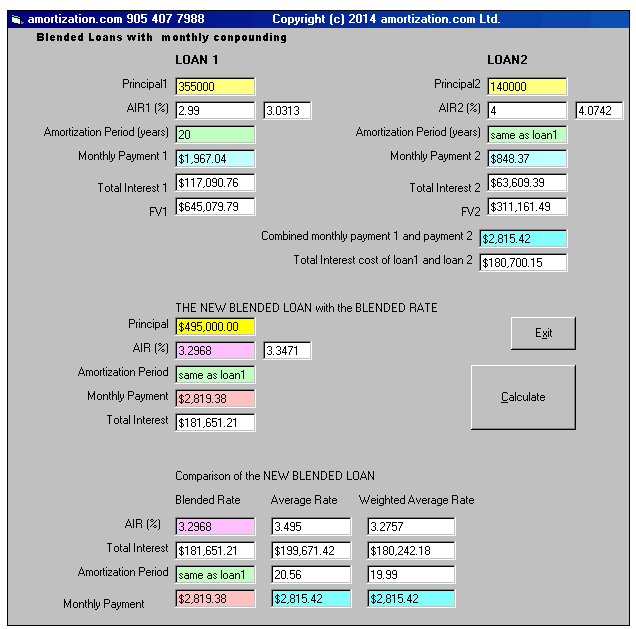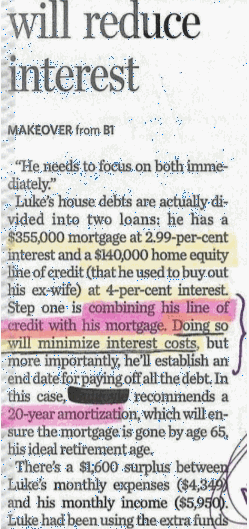Blended Loans
Are you contemplating combining two loans for the convenience of tracking one monthly payment? If the answer is yes, you will want to know what interest rate will give you the borrower the best financial advantage.
Before you can appreciate the viability of blending two loans it will help to understand the phrase, .. deemed reinvestment. When you put money in a GIC the Bank will pay you a guaranteed interest on your money at the end of the year. If the face value of your GIC plus the interest is reinvested at the end of the year in another GIC for another year at the same initial rate and you continue renewing at the same interest rate this is called deemed reinvestment and you are receiving compound interest. The interest rate or return at the end of the second year is also called the effective interest rate you are receiving. This same concept applies for lending and investing. It is also used to evaluate and compare loans and mortgages but the time period is one month for monthly payment loans or mortgages. It is difficult to get a GIC that’s pays interest monthly instead of yearly and if you do, the rate is usually lower. Now pertaining to mortgages, it is also difficult for a lender to reinvest each monthly mortgage payment as it is received from you thus the deemed reinvestment calculation is more of an ideal scenario calculation with respect to loans and mortgages. Loans and mortgages are calculated exactly the same way, the only difference being the monthly interest factor, but I digress!
Suppose you borrowed $1000 for one year at an annual interest rate of 12% the monthly payments would be $88.85. If you were in possession of an amortization schedule you would see that at the end of the year the schedule shows total interest you paid to the lender was $66.18 not $120 as you might expect (0.12 x 1000 = 120). The lenders deemed reinvestment calculation predicts that if he reinvests each monthly payment of $88.85 at the same interest rate he would receive ideally $126.83 not $120 due to compounding. In mathematical jargon, a 12% annual interest rate charged on your $1000 loan is worth to the lender, 12 months in the future, $1,126.83 and that is called the future value (FV). It is a common practice to calculate the future value (FV) of loans or mortgages for comparison purposes.

Now let me use an example from a major Canadian newspaper, in which a “financial planner” advises a client. The planner said, the client by combing his line of credit with his mortgage will minimize interest costs without any mention of the interest rate of the blended loan. How the lender calculates the blended loan rate will determine the costs/savings .The example above indicates three methods, two are obvious and one not so obvious to a novice of mathematics of how to arrive at the new blended rate for the blended loan.
BLENDED RATE
I consider this rate, 3.2968% to be like a maximum speed limit. It’s the maximum rate that should be charged because it gives the lender a FV of the blended loan to be exactly the same as the addition of the two separate loans FV’s. The Bank is actually winning here on an additional level and not just being fair because if the second loan was a car loan the Bank has now locked you into twenty years of hidden car payments instead of maybe four or five years.
AVERAGE RATE
The average rate of 3.495% costs you the most interest, $199,671 and takes approximately a half a year longer (0.56) to pay off the blended loan at a monthly payment that is $3.96 lower. It is usually mathematically proper to compare the same cash flows over the same period of time.
WEIGHTED AVERAGE RATE
In this particular example the weighted average of 3.2757% would be most beneficial to the borrower because it has the lowest interest cost and the lowest monthly payment and the lowest amortization period (19.99 years). A consumer is wise to at least have these three benchmark rates available in order to make the proper decision!
I will end by stating, a financial person dealing with mortgages at one of the big Banks in Canada would not give me what rate their Bank would charge. The reason was this Bank only does this for non hypothetical loans and only for their clients (articles written in the newspaper are hypothetical I guess). So much for transparency and Financial Literacy in Banking Industry!

